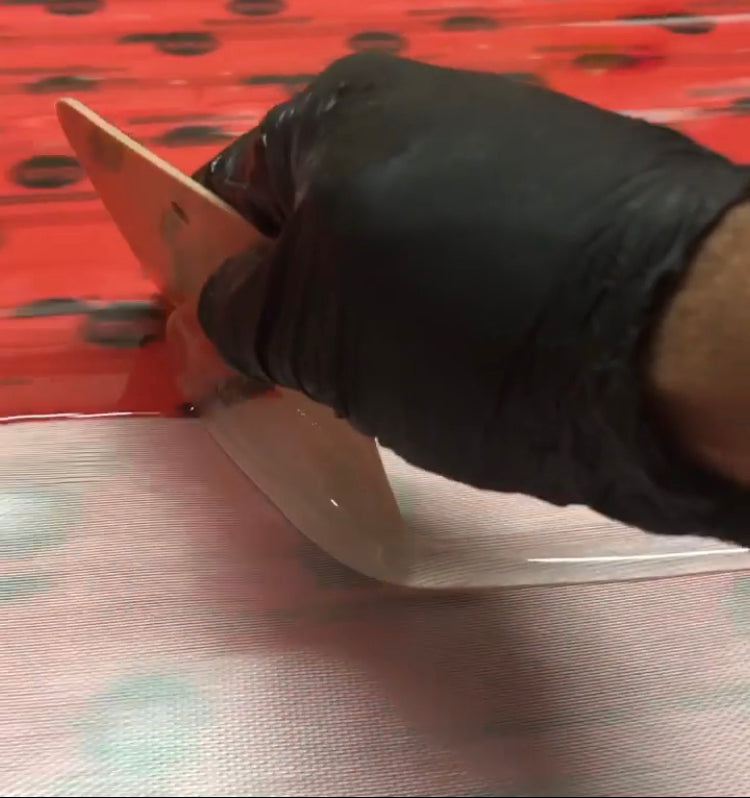
My Resin is Tacky – How do I harden Sticky Epoxy?

If you noticed the sicky, tacky or runny resin on your project, don't worry! When mixing your resin and hardener, the chemical reaction occurs. The main reason is caused by inaccurate measuring two ingredients: resin and hardener, or not mixing it thoroughly. The most common sticky problems are:
- Tacky, Sticky Resin: the problem occurs when two components – A and B are measured and mixed inaccurate or curing in cold temperatures. Resin starts to cure but does not go all the way completely. You should find a warmer spot to move your piece such as room or working office. If artwork doesn't dry, try to repour with a new fresh coat.
- Runny Resin: when the resin is not quite liquid or hard, the mixture will be left with a mess. If you will add to much colorant or not follow the correct directions – 1:1 ratio of resin and hardener, the resin will be left with a mess. How to fix uncured epoxy resin? The old gooey resin will need to be scraped off and then add another coat of resin to the surface.
- Soft Spots on the Surface: if you end your work with a sticky spots on a cured surface, you may used unmixed mixture from yoru mixing container. Remove liquid resin and apply a new layer.
There are few simple techniques to fix it:
Resin mixture that remains tacky days after being poured will stay sticky. Keep in mind, resin cures properly if you will measure and mix resin correctly.
Measure Baltic Day in equal amounts by volume ( 1:1 Ratio ):
Adding too less or too much resin or hardener will alter the reaction and the mixture will not be cured completely. Always follow manufacturer's instructions. Mix Baltic Day resin atleast 3-7 minutes:
Use a mixer or stirring sticks to mix very well the mixture. Scrape the bottom and sides of the mixing container as you mix. Poorly mixed resin will stuck to the sides or bottom and will not cure properly ( sticky spots will appear ).

Tacky/Sticky Situation 1: Tacky resin
The cured resin is sticky like a tape. This happend when resin has started to cure but the surface of the project is still tacky. It looks like gluey side of the tape. Follow these easy steps to fix this common problem:
Why is my resin flexible? What I did wrong? Why this happened?
- The most common reason – not measuring resin and hardener accurately. Always follow the manufacturer's directions of 1:1 ratio. Baltic Day resin must be mixed in precisely equal amounts.
- Working space temperature – if temperature of the room is too cold, resin will not cure properly. The best temperature to cure fully is 73-86°F or 23-31C.
- Poorly mixed – mix at least 4 minutes and make sure to scrape around of your mixing container.
How to easily fix sticky Resin
- Recoat: Add another fresh layer of doming resin on top of the sticky spots. ( make sure to mix and measure properly ).
- Move your artwork into a warmer spot for 24 and let it dry ( resin drying time 20-24 hours ).
- Sand the entiry sticky surface off with 80-grit sandpaper and pour another resin coat layer.
- For the smaller sticky spots, you can try resin spray, which dries very quickly leaving a clear and gloss finish. It's very easy to use and great for small projects. Seal with acrylic based spray or gloss sealer spray.

Runny Resin situation 2: Liquid/Runny Resin
Resin that may is not solid, hard or liquid enough, wet and gooey.
What I did wrong? Reasons why this happened:
- Always follow the mixing instructions. Baltic Day 1:1 ratio Artist's resin requires equal parts of both components by VOLUME not WEIGHT in order to cure properly.
- Adding incorrect amount of hardener will not make the curring process work faster. Baltic Day Resin is specially formulated for casting and coating and must be measured correctly by volume.
- If you by accident mixed two parts of the same components or incorrect ratio 2:2 or 2:1 – resin or hardener: resin will not cure properly. In order to harden, the chemical reaction requires EQUAL amounts!
- Be careful while adding too much resin colorant: if you add too much colour pigments ( more than 6% of the total volume of your polyester resin and hardener combined ). Let's say you will use 100ml resin and hardener – total 100ml uv resin + 100ml hardener = 100ml, don't use more than 6% of colored dye ).
How to easily fix this problem
- Scrap uncured resin off! If your area is full of gooey, gummy or runny resin, scrap as much wet mixture as possible. Do not add another layer on top until artwork be ready for a new coat.
- Remove all the wet resin material, otherwise it may leak into the fresh layer of resin.
- If after scraping the sticky resin, crackrs or large craters of resin charms are preset, mix new resin and fill the voids.
- Before pouring a fresh coat of Baltic Day resin, be sure you've scraped your art or floor piece down. This time make sure you have measured and mixed properly and thoroughly.

Sticky Resin Situation 3: Soft or Wet Spots
It's possible that after your resin has cured, but there are random wet or soft spots left on the surface. The reasons why it happened:
- Always scrape the sides and bottom of your container while mixing epoxy resin.
- Never scrape the sides when pouring Baltic Day resin onto your art piece.If resin mixture is not mixed correctly, the unmixed material will stuck to the sides, it will create a soft spots.
Recommendation: BALTIC DAY 1:1 Ratio Crystal Clear Epoxy Resin
Baltic Day art resin is very well suited for the casting, coating and production of epoxy jewelry. It cures very fast that finished casting can be removed from mold after 7-8 HOURS. Simple 1:1 mixing ratio and has a short 40 minutes working time. Our resin has a very good color separation, self leveling, self degassing, 100% resistant to yellowing from UV exposure and odor free.
This resin kit comes with all accessories you will need: resin and hardener, 2 measuring cups, plastic spreader, 20x wooden sticks, pair of nitrile gloves. A perfect resin kit for beginners and professionals. Highest quality resin will not leave wet/sticky spots on your cured artwork.
How to easily Fix Wet/Soft Resin
- Use a sandpaper: we recommend 80 or 90 grit coarse sand paper. Sand down the cured surface and clean away with napkin. Sand those sticky parts down, removing away the sanding residue.
- Remove gooey resin as much as you can. Unremoved material will leak out from under the new and fresh coat.
- Once you've scraped and surface is clear of dust, then pour a new coat of Baltic Day resin.
Tips and Tricks to avoid Sticky Resin:
- Work only in a warm environment ( 74-81°F or 24-31C ). Cold temperature will affect the resin curring process.
- Remember to add maximum 6% colourant to your resin.
- Measure Baltic Day resin in equal amounts by volume 1:1
- Mix your resin thoroughly for at least 3-5 minutes scraping the bottom and sides.
- Apply a fresh layer of resin to sticky/tacky spots ( not to the whole working surface ).
- DON'T scrape the mixing container while pouring!
Share your best techniques in the comment below

Comments
Leave a comment